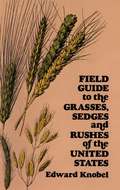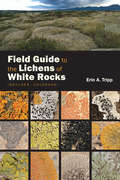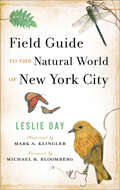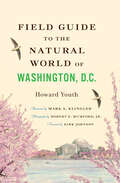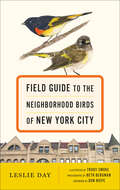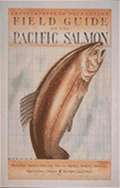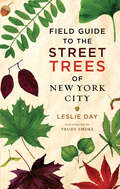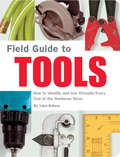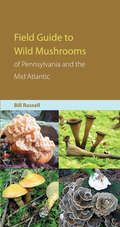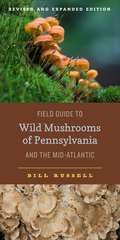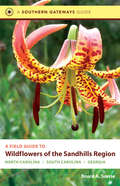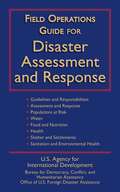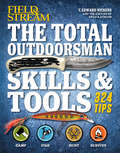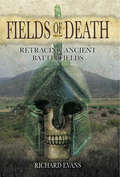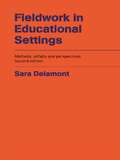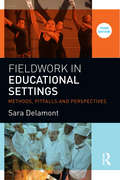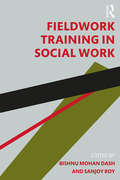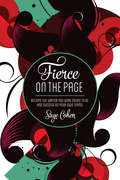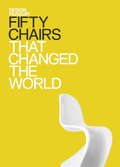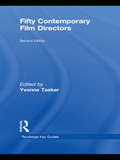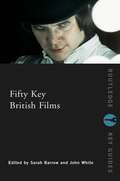- Table View
- List View
Field Guide to the Grasses, Sedges, and Rushes of the United States
by Edward KnobelWith its clear, easy-to-use format, accurate line drawings, and concise descriptions, Edward Knobel's Field Guide can help make you an expert at identifying the common grasses, sedges, and rushes of the United States. Over 370 of the most common species are accurately described in this handy volume: varieties of timothy, rye, foxtail, fescue, bluegrass, nutrush, cottongrass, bulrush, etc. Knobel's emphasis is upon wild varieties of these plants common to the eastern and central United States, but many cultivated strains and food grains such as rice, oats, and maize are also included.A general key on the first page of this book allows you to fit each plant into one of several basic structural categories. Further subdivisions, classified according to the structure of the ear and spikelet (the flowering part of the plant) identify the particular species. Each plant is then described according to common name, Latin name, height, color of flower and stem, texture, smell (if applicable), habitat, and even edibility. Close resemblances to other varieties are also noted, which helps to make identifications even easier. Each description is also accompanied by a drawing of an entire plant, and a second drawing of the actual spikelet (with scale of the drawing noted). The author includes a total of 28 plates and over 600 line drawings.This new Dover edition has been completely revised, with common and scientific nomenclature updated, by Mildred E. Faust, Professor of Botany, Emeritus, Syracuse University.
Field Guide to the Lichens of White Rocks: (Boulder, Colorado)
by Erin TrippField Guide to the Lichens of White Rocks is a careful examination of the lichens that occur at the ecologically important and lichenologically rich urban outcropping of Fox Hills sandstone known as White Rocks Nature Preserve, located in Boulder County, Colorado. This extensively illustrated field guide presents detailed information on the macroscopic and microscopic features needed to identify species, as well as extensive notes on how to differentiate closely related lichens—both those present at White Rocks and those likely to be found elsewhere in western North America. This guide is one of the only complete lichen inventories of a sandstone formation in North America and covers all constituents including the crustose microlichen biota, traditionally excluded from other inventories. A short introduction and glossary equip the reader with basic information on lichen morphology, reproduction, and ecology. Visitors to White Rocks Nature Preserve must schedule staff-led public tours or set up sponsored research projects through the City of Boulder Open Space and Mountain Parks, and there are many other outcroppings of Fox Hills sandstone across the West, making Field Guide to the Lichens of White Rocks a significant resource for anyone interested in this unique environment. This accessible, user-friendly guide will also be valuable to naturalists and lichenologists around the world as well as educators, conservationists, and land managers concerned with the growing significance of open spaces and other protected urban areas throughout North America. The University Press of Colorado gratefully acknowledges the generous support of the University of Colorado Natural History Museum, City of Boulder Parks & Open Spaces, and the Colorado Native Plant Society board and members toward the publication of this book.
Field Guide to the Natural World of New York City
by Leslie Day"This little gem fills you in on everything finned, furred, feathered, or leafed, and how to find it, in all five boroughs."—House and GardenSecond place for scholarly/reference books (design), Bookbinders' Guild of New York 2008 New York Book Show.New York just might be the most biologically diverse city in temperate America. The five boroughs sit atop one of the most naturally rich sites in North America, directly under the Atlantic migratory flyway, at the mouth of a 300-mile-long river, and on three islands—Manhattan, Staten, and Long. Leslie Day, a New York City naturalist, reveals this amazing world in her Field Guide to the Natural World of New York City. Combining the stunning paintings of Mark A. Klingler with a variety of photographs and maps, this book is a complete guide for the urban naturalist—with tips on identifying the city's flora and fauna and maps showing the nearest subway stop.Here is your personal guide to the real wild side of America’s largest city. Throw it in your backpack, hop on the subway, and explore.
Field Guide to the Natural World of New York City
by Leslie Day“This little gem fills you in on everything finned, furred, feathered, or leafed, and how to find it, in all five boroughs” (House and Garden).New York just might be the most biologically diverse city in temperate America. The five boroughs sit atop one of the most naturally rich sites in North America, directly under the Atlantic migratory flyway, at the mouth of a 300-mile-long river, and on three islands?Manhattan, Staten, and Long.Leslie Day, a New York City naturalist, reveals this amazing world in her Field Guide to the Natural World of New York City. Combining the stunning paintings of Mark A. Klingler with a variety of photographs and maps, this book is a complete guide for the urban naturalist?with tips on identifying the city's flora and fauna and maps showing the nearest subway stop.Here is your personal guide to the real wild side of America’s largest city. Throw it in your backpack, hop on the subway, and explore.“Dr. Day . . . A sort of Julia Child of nature.” —Ellen Pall, New York Times“Provides historic facts, photographs and maps to give a snapshot of the city’s natural resources and to remind hard-charging New Yorkers of the unchanging parts of their environment.” —Sally Goldenberg, Staten Island Advance“This book should be in every New Yorker’s library as both reference and inspiration for low-carbon-impact journeys to places of unexpected beauty and tranquility.” —Crawford-Doyle Booksellers Newsletter“You may well wonder why I am reviewing a book about New York city when we preach 'local, local, local' throughout these pages. I'll tell you, because this beautifully illustrated handbook is a wonderful example of exploring the bucolic city. . . . All illustrated with gorgeous watercolors by Klingler. We should have one of these. But in the meantime, you will find many of the same species in our fair cities., so why not pick up a copy for inspiration?”—Minneapolis Observer Quarterly
Field Guide to the Natural World of Washington, D.C.
by Howard YouthA field guide to plants and animals commonly found in the nation's capital.Winner of the Design and Effectiveness Award of the Washington PublishersNature awaits discovery at almost every turn in the complex ecosystem of Washington, D.C. In parks large and small, within the District's gardens, and on public streets, there is tremendous biodiversity. In Field Guide to the Natural World of Washington, D.C., naturalist Howard Youth takes us on an urban safari, describing the wild side of the nation's capital.Beyond the abundant wildlife that can be seen in every neighborhood, Washington boasts a large park network rich in natural wonders. A hike along the trails of Rock Creek Park, one of the country’s largest and oldest urban forests, quickly reveals white-tailed deer, eastern gray squirrels, and little brown bats. Mayapples, Virginia bluebells, and red mulberry trees are but a few of the treasures found growing at the National Arboretum. A stroll along the Potomac and Anacostia Rivers might reveal stealthy denizens such as bullfrogs, largemouth bass, and common snapping turtles. Detailed drawings by Carnegie artist Mark A. Klingler and photography by Robert E. Mumford, Jr., reveal the rich color and stunning beauty of the flora and fauna awaiting every D.C. naturalist.Whether seeking a secluded jog or an adventurous outing, residents and tourists alike will find this handsome guide indispensable for finding oases away from the noise of the city.
Field Guide to the Neighborhood Birds of New York City
by Leslie DayNew York City’s favorite naturalist returns with a guided tour of the beautiful birds living in the five boroughs.Look around New York, and you’ll probably see birds: wood ducks swimming in Queens, a stalking black-crowned night-heron in Brooklyn, great horned owls perching in the Bronx, warblers feeding in Central Park, or Staten Island’s purple martins flying to and fro. You might spot hawks and falcons nesting on skyscrapers or robins belting out songs from trees along the street.America’s largest metropolis teems with birdlife in part because it sits within the great Atlantic flyway where migratory birds travel seasonally between north and south. The Big Apple’s miles of coastline, magnificent parks, and millions of trees attract dozens of migrating species every year and are also home year-round to scores of resident birds.There is no better way to identify and learn about New York’s birds than with this comprehensive field guide from New York City naturalist Leslie Day. Her book will quickly teach you what each species looks like, where they build their nests, what they eat, the sounds of their songs, what time of year they appear in the city, the shapes and colors of their eggs, and where in the five boroughs you can find them?which is often in the neighborhood you call home. The hundreds of stunning photographs by Beth Bergman and gorgeous illustrations by Trudy Smoke will help you identify the ninety avian species commonly seen in New York. Once you enter the world of the city’s birds, life in the great metropolis will never look the same.“‘Take this guide wherever you go,’ [Day] implores readers in the introduction. And we hope many do, since it reveals a New York we long to see, the wild, beautiful city of birds known to Audubon, Chapman, and Griscom.” —Chuck Hagner, BirdWatching Magazine“An excellent guide for New York City residents. If you have any interest in the birds around you (and there are plenty of birds around you, even in NYC), this guide will really open your eyes.” —Birder's Library“Day’s deeply researched and richly illustrated Field Guide to the Neighborhood Birds of New York City will be indispensable to locals and tourists alike.” —Sierra“Will fill a niche for beginning birders and backyard watchers in the northeastern U.S.” —Choice“You don’t have to live in or be visiting New York to enjoy this book.” —Times Literary Supplement (UK)
Field Guide to the Neighborhood Birds of New York City
by Leslie Day Don RiepeNew York City's favorite naturalist is back with a guided tour of the Big Apple that unveils the beautiful birds living in its midst.Winner of the Hardcover Nonfiction (Design) of The New York Book Show, Illustrated Text of the Washington PublishersLook around New York, and you’ll probably see birds: wood ducks swimming in Queens, a stalking black-crowned night-heron in Brooklyn, great horned owls perching in the Bronx, warblers feeding in Central Park, or Staten Island’s purple martins flying to and fro. You might spot hawks and falcons nesting on skyscrapers or robins belting out songs from trees along the street. America’s largest metropolis teems with birdlife in part because it sits within the great Atlantic flyway where migratory birds travel seasonally between north and south. The Big Apple’s miles of coastline, magnificent parks, and millions of trees attract dozens of migrating species every year and are also home year-round to scores of resident birds. There is no better way to identify and learn about New York’s birds than with this comprehensive field guide from New York City naturalist Leslie Day. Her book will quickly teach you what each species looks like, where they build their nests, what they eat, the sounds of their songs, what time of year they appear in the city, the shapes and colors of their eggs, and where in the five boroughs you can find them—which is often in the neighborhood you call home. The hundreds of stunning photographs by Beth Bergman and gorgeous illustrations by Trudy Smoke will help you identify the ninety avian species commonly seen in New York. Once you enter the world of the city’s birds, life in the great metropolis will never look the same.
Field Guide to the Street Trees of New York City
by Leslie DayImagine an urban oasis with hundreds of thousands of trees and whose mayor wants to plant a million more. That sylvan place is New York City, and this is a guide to the diverse trees that line its streets.Field Guide to the Street Trees of New York City acquaints New Yorkers and visitors alike with fifty species of trees commonly found in the neighborhoods where people live, work, and travel. Beautiful, original drawings of leaves and stunning photographs of bark, fruit, flower, and twig accompany informative descriptions of each species. Detailed maps of the five boroughs identify all of the city’s neighborhoods, and specific addresses pinpoint where to find a good example of each tree species. Trees provide invaluable benefits to the Big Apple: they reduce the rate of respiratory disease, increase property values, cool homes and sidewalks in the summer, block the harsh winds of winter, clean the air, absorb storm water runoff, and provide habitat and food for the city’s wildlife.Bald cypress, swamp oak, silver linden, and all of New York’s most common trees are just a page turn away. Your evening walk will never be the same once you come to know the quiet giants that line the city's streets.
Field Guide to Tools
by John KelseyFinally, a field guide to identifying and utilizing more than 100 tools, from an awl to a propane torch, from a table saw to a screwdriver! Field Guide to Tools is the ultimate guide to all the gear any handyperson requires. Hardware stores, home stores, and garden stores are full of unrecognizable items--here's how you can find out what tool is appropriate for your job and just how to go about employing it. Descriptive pages outline the basic history and use for each tool, inventive alternate functions, and operating principles; component parts are illustrated by helpful diagrams; and more than 100 full-color photographs aid in identification while at the hardware store. Step-by-step directions walk you through the basics of using each tool properly and safely. Don't attempt another at-home fix-it project without Field Guide to Tools!
Field Guide to Wild Mushrooms of Pennsylvania and the Mid-Atlantic (Keystone Books)
by Bill RussellTo most Americans, mushrooms are the brown lumps in the soup one uses to make a tuna casserole, but to a select few, mushrooms are the abundant yet often well-hidden delicacies of the forests. In spite of their rather dismal reputation, most wild mushrooms are both edible and delicious, when prepared properly. From the morel to the chanterelle and the prolific and aptly named chicken of the woods, mushrooms can easily be harvested and enjoyed, if you know where to look and what to look for. Bill Russell’s Field Guide to the Wild Mushrooms of Pennsylvania and the Mid-Atlantic helps the reader learn just that—specifically for the often-neglected East Coast mushrooms of the United States and Canada.Suited to both the novice and the experienced mushroom hunter, this book helps the reader identify mushrooms with the use of illustrations, descriptions, and environmental observations. Russell’s fifty years of experience in hunting, studying, and teaching about wild mushrooms have been carefully distilled into this easy-to-use and well-designed guide. The book is divided into the four seasons, each with its unique mushroom offerings. Each mushroom section includes a detailed description, information about the mushroom’s biology, tips on where the mushroom is most likely to be found, and a short “nutshell” description for quick reference. The book also includes color photographs of each of the mushrooms described.Russell’s Field Guide to the Wild Mushrooms of Pennsylvania and the Mid-Atlantic shows the reader not only how to identify the most common mushrooms found in the region but also how to avoid common copycats—and what to do with the mushrooms once they’re identified and harvested. With both color illustrations and insightful descriptions of one hundred of the area’s most common mushrooms, Field Guide is an indispensable reference for the curious hiker, the amateur biologist, or the adventurous chef.
Field Guide to Wild Mushrooms of Pennsylvania and the Mid-Atlantic: Revised and Expanded Edition (Keystone Books)
by Bill RussellThis revised and expanded edition of mushroom expert Bill Russell’s popular Field Guide to Wild Mushrooms of Pennsylvania and the Mid-Atlantic provides both novice and experienced mushroom foragers with detailed, easy-to-use information about more than one hundred species of these fungi, including twenty-five varieties not found in the previous guide.From the Morel to the Chanterelle to the aptly named Chicken of the Woods, mushrooms of the mid-Atlantic region can be harvested and enjoyed, if you know where to look. Each entry in this field guide contains a detailed description, current scientific classification, key updates and information from recent studies, and high-quality color photographs to aid in identification. Thoughtfully organized by season, the guide shows you how to locate and identify the most common mushrooms in the region and recognize look-alikes—and explains what to do with edible mushrooms once you’ve found them.Featuring over one hundred full-color illustrations and distilling Russell’s fifty years of experience in hunting, studying, and teaching about wild mushrooms, Field Guide to Wild Mushrooms of Pennsylvania and the Mid-Atlantic is an indispensable reference for curious hikers, amateur biologists, adventurous chefs, and mycophiles of all stripes.
Field Guide to Wild Mushrooms of Pennsylvania and the Mid-Atlantic: Revised and Expanded Edition (Keystone Books)
by Bill RussellThis revised and expanded edition of mushroom expert Bill Russell’s popular Field Guide to Wild Mushrooms of Pennsylvania and the Mid-Atlantic provides both novice and experienced mushroom foragers with detailed, easy-to-use information about more than one hundred species of these fungi, including twenty-five varieties not found in the previous guide.From the Morel to the Chanterelle to the aptly named Chicken of the Woods, mushrooms of the mid-Atlantic region can be harvested and enjoyed, if you know where to look. Each entry in this field guide contains a detailed description, current scientific classification, key updates and information from recent studies, and high-quality color photographs to aid in identification. Thoughtfully organized by season, the guide shows you how to locate and identify the most common mushrooms in the region and recognize look-alikes—and explains what to do with edible mushrooms once you’ve found them.Featuring over one hundred full-color illustrations and distilling Russell’s fifty years of experience in hunting, studying, and teaching about wild mushrooms, Field Guide to Wild Mushrooms of Pennsylvania and the Mid-Atlantic is an indispensable reference for curious hikers, amateur biologists, adventurous chefs, and mycophiles of all stripes.
A Field Guide to Wildflowers of the Sandhills Region
by Bruce A. SorrieFeaturing over 600 wildflowers, flowering shrubs, and vines, this user-friendly field guide is the first to focus on the rare, fragile lands and species of the Sandhills region of the Carolinas and Georgia. Characterized by longleaf pine forests, rolling hills, abundant blackwater streams, several major rivers, and porous sandy soils, the Sandhills region stretches from Fayetteville, North Carolina, southwest to Columbus, Georgia, and represents the farthest advance of the Atlantic Ocean some 2 million years ago. Wildflowers of the Sandhills Regionis arranged by habitat, with color tabs to facilitate easy browsing of the nine different natural communities whose plants are described here. Bruce A. Sorrie, a botanist with over 30 years of experience, includes common plants, region-specific endemics, and local rarities, each with its own species description, and over 540 color photos for easy identification. The field guide's opening section includes an introduction to the Sandhills region's geology, soil types, and special relationship to fire ecology; an overview of rare species and present conservation efforts; a glossary and key to flower and leaf structures; and a listing of gardens, preserves, and parklands in the Sandhills region and nearby where wildflowers can be seen and appreciated. Wildflower enthusiasts and professional naturalists alike will find this comprehensive guide extremely useful.
Field Operations Guide for Disaster Assessment and Response
by U.S. Agency for International DevelopmentIn developing this third revision of version 4.0 of the Field Operations Guide for Disaster Assessment and Response, the Office of U.S. Foreign Disaster Assistance (OFDA) of the United States Agency of International Development (USAID) has drawn on the expertise of numerous state, national, and international agencies and organizations. Selected sources of information include the United Nations High Commissioner for Refugees' Handbook for Emergencies, the United Nations Office for the Coordination of Humanitarian Affairs' United Nations Disaster Assessment and Coordination Field Handbook, and the U.S. Public Health Service's Handbook of Environmental Health, among others. The Field Operations Guide for Disaster Assessment and Response has been created as a reference tool for individuals sent to disaster sites to undertake initial assessments or to participate as members of a Disaster Assistance Response Team (DART). It contains information on general responsibilities for disaster responders, formats and reference material for assessing and reporting on populations at risk, DART position descriptions and duty checklists, descriptions of OFDA stockpile commodities, information for working with military in the field, and much more. Its myriad resources, extensive information, and handy compact format make this field guide a necessary companion for those participating in a variety of disaster assessment and response field operations.
Field Research in Political Science
by Diana Kapiszewski Lauren M. MacLean Benjamin L. Read Diana Kapiszewski Lauren M. MacleanField research - leaving one's home institution in order to acquire data, information or insights that significantly inform one's research - remains indispensable, even in a digitally networked era. This book, the first of its kind in political science, reconsiders the design and execution of field research and explores its role in producing knowledge. First, it offers an empirical overview of fieldwork in the discipline based on a large-scale survey and extensive interviews. Good fieldwork takes diverse forms yet follows a set of common practices and principles. Second, the book demonstrates the analytic benefits of fieldwork, showing how it contributes to our understanding of politics. Finally, it provides intellectual and practical guidance, with chapters on preparing for field research, operating in the field and making analytic progress while collecting data, and on data collection techniques including archival research, interviewing, ethnography and participant observation, surveys, and field experiments.
Field & Stream: 324 Tips (Field & Stream)
by T. Edward Nickens The Editors of Field & StreamThe editor-at-large of Field & Stream guides you through the skills and tools you need to be a better outdoorsman and be ready for anything. KNOW IT ALL What makes someone a total outdoorsman? It&’s a mix of know-how, enthusiasm, experience…and having the right tools. In this follow-up to the top-selling Total Outdoorsman Manual author T. Edward Nickens returns with another 300+ hints on how to get the most from your hunting, fishing, and camping trips…and how to survive if something goes wrong. CAMP IN STYLE What do you really need to bring along to sleep comfortably, keep away varmints, set up an amazing camp kitchen, and handle on-the-spot butchering? Eddie knows, and shares in detail. HUNT BETTER The skills and tools you need track your prey, make the toughest shots, master bowhunting and knife skills, and haul, butcher, and cook wild game. FISH SMARTER Everything you need to master fly fishing, baitcasting, and spinning, as well as surefire ways to get the most out of your motorboat, canoe, or kayak whether you&’re fishing on a shoestring budget or investing in a dream trip. SURVIVE ANYTHING When the chips are down and help is far away, these are the skills that can save your life, and the tools that will get you out of any wilderness situation safely.
Fields of Death: Retracing Ancient Battlefields
by Richard EvansRichard Evans revisits the sites of a selection of Greek and Roman battles and sieges to seek new insights. The battle narratives in ancient sources can be a thrilling read and form the basis of our knowledge of these epic events, but they can just as often provide an incomplete or obscure record. Details, especially those related to topographical and geographical issues which can have a fundamental importance to military actions, are left tantalisingly unclear to the modern reader. The evidence from archaeological excavation work can sometimes fill in a gap in our understanding, but such an approach remains uncommon in studying ancient battles. By combining the ancient sources and latest archaeological findings with his personal observations on the ground, Richard Evans brings new perspectives to the dramatic events of the distant past. For example, why did armies miss one another in what we might today consider relatively benign terrain? Just how important was the terrain in determining victory or defeat in these clashes.The author has carefully selected battles and sieges to explore, first of all to identify their locations and see how these fit with the ancient evidence. He then examines the historical episodes themselves, offering new observations from first-hand study of the field of battle along with up-to-date photographs, maps and diagrams. In the process he discusses whether and how the terrain has since been changed by land use, erosion and other factors, and the extent to which what we see today represents a real connection with the dramatic events of the distant past. This first volume considers: 1. The Greek Victory over the Persians at Marathon (490 BC)2. Leonidas and his Three Hundred Spartans at Thermopylae (480 BC)3. The Athenian Siege of Syracuse (414-413 BC)4. The Syracusan Siege of Motya (397 BC)5. Alexander's Defeat of Darius at Issus (333 BC)6. Hannibal's Victory at Cannae (216 BC)7. Titus Quinctius Flamininus and Philip V at Cynoscephalae (197 BC)8. Gaius Marius' Victory over the Teutones at Aquae Sextiae (102 BC)9. Octavian versus Antony and Cleopatra of Egypt: The Battle of Actium (31 BC)10. The First Battle of Bedriacum (April AD 69)
Fieldwork in Educational Settings: Methods, Pitfalls and Perspectives
by Sara DelamontExtensively revised and updated, this new edition of Fieldwork in Educational Settings will be welcomed by researchers and academics in education and the social sciences. Embracing both sociological and anthropological approaches to qualitative research, the book covers education inside and beyond schools. It emphasises writing up ethnographic research and getting the project finished, and is packed with examples from research in progress.This new edition brings the original text right up to date for new researchers. There is an additional chapter on computer software for data handling and attention is given to the implications of postmodernism for writing up research. The examples given are taken from the latest research, replacing those from the first edition. This is an indispensable handbook by an author whose work on this subject is widely recognised as being an essential resource for the researcher in education.
Fieldwork in Educational Settings: Methods, pitfalls and perspectives
by Sara DelamontFieldwork in Educational Settings is widely recognised as part of the essential reading for the researcher in education. It instructs those new to qualitative educational research how to find interesting research sites, collect great data, analyse them responsibly, and then find the right audience to hear, use, and build upon their findings successfully. The revised and updated third edition includes the latest developments in authoethnography, data collection, analysis and dissemination, and is illustrated throughout with up-to-the minute examples of real world research. It embraces both sociological and anthropological approaches to qualitative educational research, using case studies from the USA, Canada, Australia and New Zealand as well as the UK. ‘Education’ is treated broadly, including higher education and non-formal settings as well as schools. Threaded throughout the book is updated content on: the internet and virtual worlds as sites for ethnography, the ethical aspects of ethnographic research, the strengths and weaknesses of autoethnography, the debates about representing data, the impact of technological innovations in all stages of qualitative research. An indispensable introduction for students and novice researchers alike, the new edition continues to illustrate and sustain the increasing popularity of qualitative methods in educational research over the past thirty years, addressing the technological and digital changes that have occurred.
Fieldwork Training in Social Work
by Bishnu Mohan Dash Sanjoy RoyThis volume is a definitive manual for students and practitioners involved in learning and developing essential theories and models for fieldwork practicum in social work education. It addresses various functional issues in field practicum, delineates proper guidelines for students and supervisors, discusses criteria of supervision and evaluation, and explores the concerns facing South Asian field practitioners. The volume focuses on traditional and non-traditional components and aspects of fieldwork and training, such as: • The value and use of educational camps and skill development workshops. • The contemporary field-level needs and strategies in social work practicum. • Formulating alternative practice theories that will allow social work practitioners to respond to the critical social problems unique to India and South Asia. The book provides multiple frameworks for teaching and learning fieldwork that integrate theory and practice and create an environment where students can develop intervention strategies using their knowledge, skills, and techniques. The volume will be indispensable reading for undergraduate and post-graduate students of social work. It will also be useful for scholars of sociology, anthropology, and development studies, and practitioners engaged in various non-governmental and international organizations.
Fierce on The Page: Become the Writer You Were Meant to Be and Succeed on Your Own Terms
by Sage CohenProduce your best work. Live your best life. Make your greatest impact. You have everything you need--and you are everything you need--to do the writing you are meant to do. And yet the path to success can be difficult to find and follow. Veteran author and writing guide Sage Cohen believes that ferocity is your best compass for finding your true way forward. She shows you how to transform your attitude and practices so you can:Unleash your creativityCultivate your strengthsOvercome resistance, fear, and other obstaclesDefine success on your own termsMove intentionally toward your goalsBecome unstoppable in your evolutionIn this collection of contemplative and inspiring essays, you'll unlock the secrets to naming your deepest desires, eliminating the challenges that hold you back, and committing to your practice. Fierce on the Page is your trustworthy companion for crafting your best writing and your best life. Join the conversation about the fierce writing life at fierceonthepage.com.
Fifty Chairs that Changed the World: Design Museum Fifty (Design Museum Fifty)
by Design Museum Enterprise LimitedEverything around us is designed and the word 'design' has become part of our everyday experience. But how much do we know about it? Fifty Chairs That Changed the World imparts that knowledge listing the top 50 chairs that have made a substantial impact in the world of British design today. From Thonet's 1870 Side Chair to Konstantin Grcic's Chair_One, each entry offers a short appraisal to explore what has made their iconic status and the designers that give them a special place in design history.
Fifty Contemporary Film Directors (Routledge Key Guides)
by Yvonne TaskerFifty Contemporary Film Directors examines the work of some of today’s most popular and influential cinematic figures. It provides an accessible overview of each director’s contribution to cinema, incorporating a discussion of their career, major works and impact. Revised throughout and with twelve new entries, this second edition is an up-to-date introduction to some of the most prominent film makers of the present day. The directors, from differing backgrounds and working across a range of genres, include: Martin Scorsese Steven Spielberg Sofia Coppola Julie Dash Shane Meadow Michael Moore Peter Jackson Guillermo Del Toro Tim Burton Jackie Chan Ang Lee Pedro Almodóvar. With further reading and a filmography accompanying each entry, this comprehensive guide is indispensable to all those studying contemporary film and will appeal to anyone interested in the key individuals behind modern cinema’s greatest achievements.
Fifty Key British Films (Routledge Key Guides)
by John White Sarah BarrowIn Fifty Key British Films, Britain's best known films such as Clockwork Orange, The Full Monty and Goldfinger are scrutinised for their outstanding ability to articulate the issues of the time. This is essential reading for anyone interested in quality, cult film.
